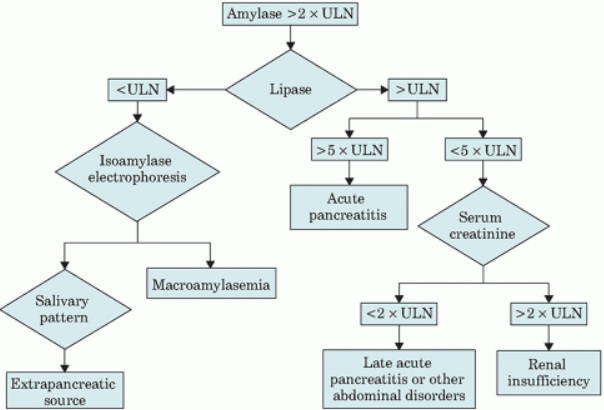What is amylase?
Amylase is an enzyme that helps your body break down carbohydrates into smaller sugar molecules. Although amylase is mostly produced by the pancreas and the salivary glands, small amounts can also come from other parts of the body.
Amylase: Normal range
Laboratories measure amylase in units per liter (U/L) or international units per liter (IU/L).
- A common reference range is about 30–110 U/L.
- However, normal ranges can vary slightly from lab to lab.
Amylase: Clinical significance
Doctors often check amylase levels—along with lipase—to evaluate for acute pancreatitis, an inflammation of the pancreas that can cause sudden and severe abdominal pain.
However, amylase can be elevated for many other reasons besides pancreatitis, which can make results difficult to interpret. Because of this, lipase is often preferred for diagnosing acute pancreatitis since it is more specific, stays elevated longer, and can be elevated in some conditions (like high triglycerides) where amylase might be normal.
Amylase increase: Causes
An elevated amylase level does not always mean you have pancreatitis. Some of the causes include:
- Acute Pancreatitis
- A common cause of elevated amylase. Often, levels rise to at least three times the normal limit.
- Note: Not everyone with acute pancreatitis has a big spike in amylase. For instance, those with chronic pancreatitis or alcohol-induced pancreatitis may have normal or only mildly elevated amylase levels.
- Other Pancreatic Conditions
- Pancreatic duct obstruction, trauma, or surgery
- Post-ERCP (endoscopic procedure): Pancreatic enzyme levels can rise temporarily.
- Salivary Gland Disorders
- Parotitis (inflammation or infection of the parotid salivary gland)
- Mumps and other viral infections affecting the salivary glands
- Macroamylasemia
- Amylase attaches to large molecules (e.g., certain antibodies), forming “macroamylase” complexes.
- These complexes are cleared from the blood more slowly, causing persistent elevation of amylase.
- Conditions such as celiac disease, HIV infection, and rheumatoid arthritis have been associated with macroamylasemia.
- Other Medical Conditions
- Diabetic ketoacidosis (some patients can have nonspecific amylase or lipase elevation)
- Renal insufficiency (reduced kidney function can decrease excretion of amylase)
- Tumors or malignancies (rarely, can cause elevated amylase)
- Gullo’s syndrome (idiopathic hyperamylasemia): A rare, benign condition where amylase (or both amylase and lipase) fluctuate without actual pancreatic disease.
Why lipase often matters more?
Lipase is another enzyme secreted by the pancreas. Like amylase, it can be measured in blood tests, but it’s generally considered:
- More sensitive for diagnosing acute pancreatitis (better at picking it up)
- Elevated for a longer time than amylase after pancreatitis begins
- Specific for pancreas problems (less likely to be increased by salivary issues or macroamylasemia)
- Useful in hypertriglyceridemia-related pancreatitis (where amylase may appear normal)
Relying on lipase levels can also reduce costs, because repeatedly checking both amylase and lipase usually doesn’t provide much additional information once a diagnosis is made.
Amylase increase: Diagnostic approach
If You Have Elevated Amylase and Symptoms of Pancreatitis
- Doctors will consider acute pancreatitis, especially if your amylase is three times the normal level or higher.
- Imaging tests such as a CT scan or MRI might be done to confirm the diagnosis or check for complications.
- Treatment will likely include pain control, fluids, and monitoring in the hospital, depending on severity.
If Amylase Is Elevated but Pancreatitis Seems Unlikely
- Your doctor will consider other causes (listed above), review medications, and possibly order additional tests (e.g., to check for macroamylasemia, salivary gland issues, or kidney function).
- If you had abdominal pain that resolved and other findings are normal, further testing may not be needed.
If Pancreatitis Is Confirmed
- Once acute pancreatitis is diagnosed, routinely rechecking amylase or lipase doesn’t usually change how you’re treated.
- Your healthcare team will focus on managing the underlying cause (e.g., gallstones, high triglycerides, alcohol use) and preventing complications.
Increased amylase diagnostic algorithm

ULN, upper limit of normal
Key Takeaways
- Amylase is an important enzyme but is not always specific to the pancreas.
- Normal amylase levels typically range from 30–110 U/L (depending on the laboratory).
- An elevated amylase can be due to many conditions, including salivary gland issues, macroamylasemia, and various abdominal disorders—not just pancreatitis.
- Lipase is often the preferred test for diagnosing acute pancreatitis because it is more sensitive and remains elevated longer.
- If you’ve been told you have a high amylase level, discuss all possible causes with your gastroenterologist to pinpoint the reason and plan next steps.
